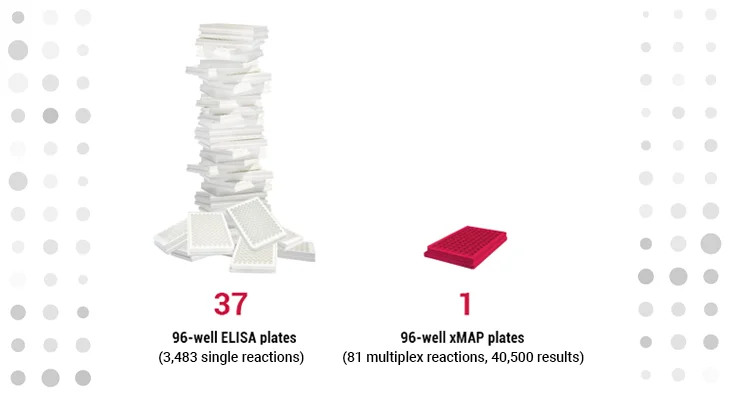Serial ELISAs Keeping You in the Lab? Switch to Multiplexing and Save
Multiplexing can be your path to saving time, money, and sample
It’s no secret that we’re big advocates for multiplexing—with more than 54,000 publications citing xMAP® Technology across dozens of applications, the benefits it offers are well-established. For protein- and nucleic acid-based applications, multiplex assays can detect up to 500 targets simultaneously in a single run, enabling users to conserve samples and providing cost- and time-saving benefits—all while generating a lot more information compared to traditional singleplex assays.
One of the hurdles of switching to multiplexing can be knowing what to look for when deciding on which platform best fits your needs. We’ve provided insight on this question and more in our recently published Multiplex Technology Guide, now available for download through our partner, Biocompare. Some of the topics reviewed in the guide include:
- The advantages of multiplexing
- The benefits of combining automation with multiplexing
- Using multiplex immunoassays to measure cytokines in human plasma
- An overview of how to develop multiplex serology assays (including for SARS-CoV-2)
- Strategies to ensure data quality prior to reporting results
By querying up to 500 different analyte targets in a single reaction, xMAP Technology gives you access to an enormous amount of data that could otherwise take multiple days and hundreds of serial ELISAs to generate.
This approach not only saves time, costs, and requires far less sample volume, it also improves consistency in your data by eliminating confounding variables introduced when running separate reactions such as different buffers, reagents, or operators. And since xMAP Technology supports automation, you can take advantage of these benefits and more with additional reductions in the amount of hands-on time needed.
This new reference guide also looks at our newest xMAP platform, the recently released xMAP® INTELLIFLEX System, which was designed to take multiplex assays to new levels. Not only does it offer an enhanced dynamic range, it also introduces a dual reporter channel that makes it possible to detect two parameters on every bead, effectively doubling the data for each analyte measured. This feature offers significant benefits for life science researchers who need to:
- Compare total and phosphorylated forms of a protein
- Monitor two distinct post-translational modifications
- Measure two antigen-specific antibody isotypes
- Test free vs. bound drug
- Detect protein cleavage and splice variants
- Perform SNP genotyping
- Measure gene expression
- And more!
Whether you’re still considering if multiplexing is right for you or you’re an advanced xMAP user, we’re confident you’ll find this reference guide valuable. Download it now for more information.
For Research Use Only. Not for use in diagnostic procedures.


